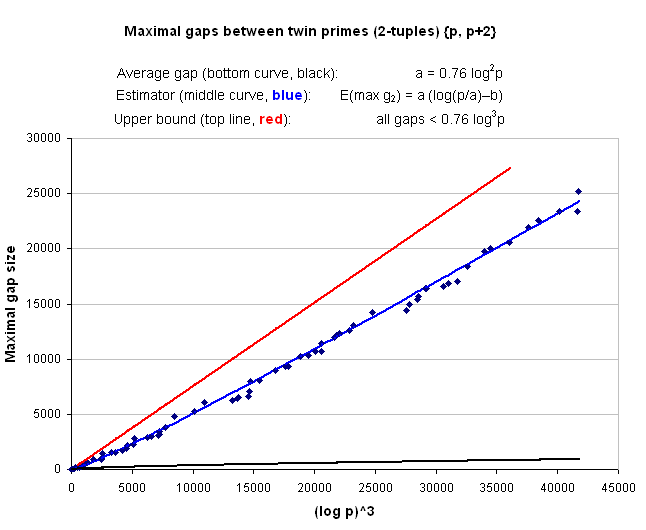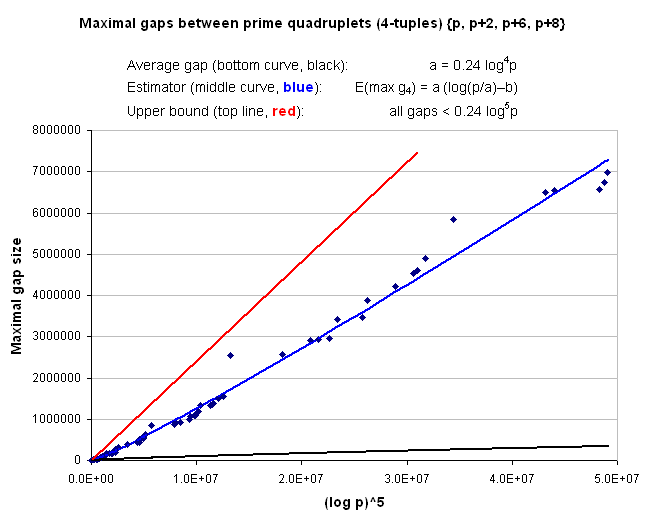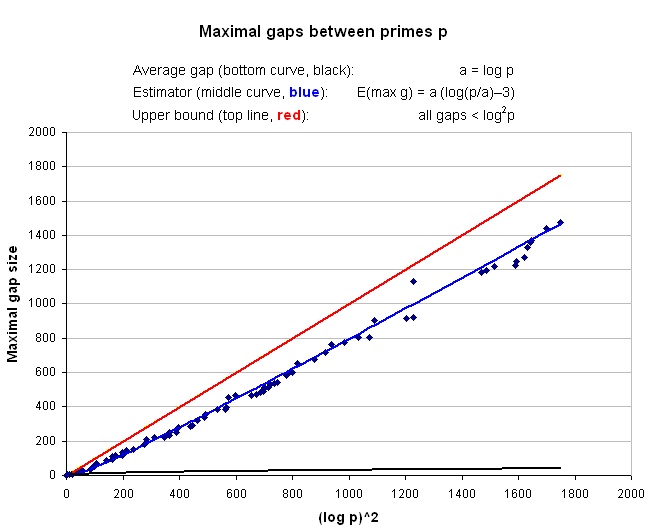The observations can be generalized to other k-tuples;
however, the numeric constants will change depending on the specific type of k-tuple.
See Appendixes for data on maximal gaps between prime
triplets (
Definitions and notation
Twin primes are pairs of consecutive primes that have the form
Prime quadruplets are clusters of four consecutive primes of the form
Prime sextuplets are clusters of six consecutive primes of the form
Prime k-tuples are clusters of k consecutive primes that have a repeatable pattern.
Thus, twin primes are a specific type of prime k-tuples, with
Gaps between prime k-tuples are center-to-center distances between consecutive k-tuples.
If the prime at the “far” end of the gap is p, we denote the gap gk(p).
For example, the gap between the quadruplets {11,13,17,19} and {101,103,107,109} is
A maximal gap is a gap that is strictly greater than all preceding gaps. In other words, a maximal gap is the first occurrence of a gap at least this size. As an example, consider gaps between prime quadruplets (4-tuples): the gap of 90 preceding the quadruplet {101,103,107,109} is a maximal gap (i.e. the first occurrence of a gap of at least 90), while the gap of 90 preceding {191,193,197,199} is not a maximal gap (not the first occurrence of a gap at least this size). A synonym for maximal gap is record gap; see e.g. OEIS Sequences A113274, A113404, A200503 (record gaps between twins, quadruplets, and sextuplets, respectively).
Hereafter p denotes a prime,
Simple conjectures for the gap size
There are simple formulas for gaps between k-tuples of a specific type. These formulas give rough estimates of the gap(A) Average gaps between prime k-tuples are
(B) Maximal gaps between prime k-tuples are
(C) Maximal gaps between prime k-tuples are asymptotically equal to
Statement (A) follows from the
Hardy-Littlewood k-tuple conjecture [9,14]
that predicts the total counts of prime k-tuples (and thereby average frequencies of k-tuples);
the constants Ck are reciprocals of the
Hardy-Littlewood constants.
For example,
Statements (B) and (C) are also conjectural – they are suggested by heuristics and supported by
large sets of known maximal gaps such as listed below for
The constants
Maximal gaps between 2-tuples (twin prime pairs) are
Maximal gaps between 4-tuples (prime quadruplets) are
Maximal gaps between 6-tuples (prime sextuplets) are
Statement (C) is stronger than (B) and analogous to the Shanks conjecture for primes [8]. Together, statements (A), (B), (C) tell us that:
Maximal gaps between prime k-tuples are at most aboutlog p times the average gap.
Can we predict the maximal gaps even better?
Probability-based heuristics can help!
Prime k-tuples are rare and seemingly random.
Life offers many examples of unusually large intervals between rare random events:
the longest runs of two-dice rolls without getting a twelve,
maximal intervals between cars crossing a bridge at night,
maximal intervals between clicks of a Geiger counter measuring very low radioactivity, etc.
Schilling gives many more statistical examples of this kind in his paper The longest run of heads [15]
and states where a is the average interval between the rare events, and T is the total observation time or lengthE(max interval) = a log(T/a) + O(a), with standard deviation of about a,
For lack of a better model,
we will simulate the distribution of prime k-tuples by a timeline of rare random events.
(A quick nod to purists: Yes, we have to remember that consecutive prime k-tuples are not independent events;
thus they are beyond the proven range of applicability of most statistical models. The same is true for consecutive primes.
But we are not proving a theorem here – just stating conjectures.)
By analogy with the above statistical formula, for maximal gaps
Here, the role of the total observation time T is played by p (we are looking for maximal gaps that occur from 0 up to p). The role of average intervals a is played by the size of average gaps between k-tuples near p, i.e. we setE(max gk(p)) = max(a, a log(p/a) − ba), with a = Ck logkp.
Is the prediction accurate?
Below are graphs and numerical data for
which shows thatE(max gk) = a log(p/a) − ab = a log p − a(log a + b) = Cklogk+1p − o(logk+1p),
Notes.
Of course, it is not guaranteed that the formula

Maximal gaps between twin primes up to 1.2 × 1015
1st twin pair: 2nd twin pair: Gap g2(p):
3 5 2
5 11 6
17 29 12
41 59 18
71 101 30
311 347 36
347 419 72
659 809 150
2381 2549 168
5879 6089 210
13397 13679 282
18539 18911 372
24419 24917 498
62297 62927 630
187907 188831 924
687521 688451 930
688451 689459 1008
850349 851801 1452
2868959 2870471 1512
4869911 4871441 1530
9923987 9925709 1722
14656517 14658419 1902
17382479 17384669 2190
30752231 30754487 2256
32822369 32825201 2832
96894041 96896909 2868
136283429 136286441 3012
234966929 234970031 3102
248641037 248644217 3180
255949949 255953429 3480
390817727 390821531 3804
698542487 698547257 4770
2466641069 2466646361 5292
4289385521 4289391551 6030
19181736269 19181742551 6282
24215097497 24215103971 6474
24857578817 24857585369 6552
40253418059 40253424707 6648
42441715487 42441722537 7050
43725662621 43725670601 7980
65095731749 65095739789 8040
134037421667 134037430661 8994
198311685749 198311695061 9312
223093059731 223093069049 9318
353503437239 353503447439 10200
484797803249 484797813587 10338
638432376191 638432386859 10668
784468515221 784468525931 10710
794623899269 794623910657 11388
1246446371789 1246446383771 11982
1344856591289 1344856603427 12138
1496875686461 1496875698749 12288
2156652267611 2156652280241 12630
2435613754109 2435613767159 13050
4491437003327 4491437017589 14262
13104143169251 13104143183687 14436
14437327538267 14437327553219 14952
18306891187511 18306891202907 15396
18853633225211 18853633240931 15720
23275487664899 23275487681261 16362
23634280586867 23634280603289 16422
38533601831027 38533601847617 16590
43697538391391 43697538408287 16896
56484333976919 56484333994001 17082
74668675816277 74668675834661 18384
116741875898981 116741875918727 19746
136391104728629 136391104748621 19992
221346439666109 221346439686641 20532
353971046703347 353971046725277 21930
450811253543219 450811253565767 22548
742914612256169 742914612279527 23358
1121784847637957 1121784847661339 23382
1149418981410179 1149418981435409 25230
The ratio g2(p)/log3p is never greater than 0.76.
(The maximal values of

Maximal gaps between prime quadruplets up to 1015:
1st 4-tuple: 2nd 4-tuple: Gap g4(p):
5 11 6
11 101 90
191 821 630
821 1481 660
2081 3251 1170
3461 5651 2190
5651 9431 3780
25301 31721 6420
34841 43781 8940
88811 97841 9030
122201 135461 13260
171161 187631 16470
301991 326141 24150
739391 768191 28800
1410971 1440581 29610
1468631 1508621 39990
2990831 3047411 56580
3741161 3798071 56910
5074871 5146481 71610
5527001 5610461 83460
8926451 9020981 94530
17186591 17301041 114450
21872441 22030271 157830
47615831 47774891 159060
66714671 66885851 171180
76384661 76562021 177360
87607361 87797861 190500
122033201 122231111 197910
132574061 132842111 268050
204335771 204651611 315840
628246181 628641701 395520
1749443741 1749878981 435240
2115383651 2115824561 440910
2128346411 2128859981 513570
2625166541 2625702551 536010
2932936421 2933475731 539310
3043111031 3043668371 557340
3593321651 3593956781 635130
5675642501 5676488561 846060
25346635661 25347516191 880530
27329170151 27330084401 914250
35643379901 35644302761 922860
56390149631 56391153821 1004190
60368686121 60369756611 1070490
71335575131 71336662541 1087410
76427973101 76429066451 1093350
87995596391 87996794651 1198260
96616771961 96618108401 1336440
151023350501 151024686971 1336470
164550390671 164551739111 1348440
171577885181 171579255431 1370250
210999769991 211001269931 1499940
260522319641 260523870281 1550640
342611795411 342614346161 2550750
1970587668521 1970590230311 2561790
4231588103921 4231591019861 2915940
5314235268731 5314238192771 2924040
7002440794001 7002443749661 2955660
8547351574961 8547354997451 3422490
15114108020021 15114111476741 3456720
16837633318811 16837637203481 3884670
30709975578251 30709979806601 4228350
43785651890171 43785656428091 4537920
47998980412211 47998985015621 4603410
55341128536691 55341133421591 4884900
92944027480721 92944033332041 5851320
412724560672211 412724567171921 6499710
473020890377921 473020896922661 6544740
885441677887301 885441684455891 6568590
947465687782631 947465694532961 6750330
979876637827721 979876644811451 6983730
The ratio g4(p)/log5p is never greater than 0.241.

Maximal gaps between prime 6-tuples up to 1015:
1st 6-tuple: 2nd 6-tuple: Gap g6(p):
7 97 90
97 16057 15960
19417 43777 24360
43777 1091257 1047480
3400207 6005887 2605680
11664547 14520547 2856000
37055647 40660717 3605070
82984537 87423097 4438560
89483827 94752727 5268900
94752727 112710877 17958150
381674467 403629757 21955290
1569747997 1593658597 23910600
2019957337 2057241997 37284660
5892947647 5933145847 40198200
6797589427 6860027887 62438460
14048370097 14112464617 64094520
23438578897 23504713147 66134250
24649559647 24720149677 70590030
29637700987 29715350377 77649390
29869155847 29952516817 83360970
45555183127 45645253597 90070470
52993564567 53086708387 93143820
58430706067 58528934197 98228130
93378527647 93495691687 117164040
97236244657 97367556817 131312160
240065351077 240216429907 151078830
413974098817 414129003637 154904820
419322931117 419481585697 158654580
422088931207 422248594837 159663630
427190088877 427372467157 182378280
610418426197 610613084437 194658240
659829553837 660044815597 215261760
660863670277 661094353807 230683530
853633486957 853878823867 245336910
1089611097007 1089869218717 258121710
1247852774797 1248116512537 263737740
1475007144967 1475318162947 311017980
1914335271127 1914657823357 322552230
1953892356667 1954234803877 342447210
3428196061177 3428617938787 421877610
9367921374937 9368397372277 475997340
10254799647007 10255307592697 507945690
13786576306957 13787085608827 509301870
21016714812547 21017344353277 629540730
33157788914347 33158448531067 659616720
41348577354307 41349374379487 797025180
72702520226377 72703333384387 813158010
89165783669857 89166606828697 823158840
122421000846367 122421855415957 854569590
139864197232927 139865086163977 888931050
147693859139077 147694869231727 1010092650
186009633998047 186010652137897 1018139850
202607131405027 202608270995227 1139590200
332396845335547 332397997564807 1152229260
424681656944257 424682861904937 1204960680
437804272277497 437805730243237 1457965740
The ratio g6(p)/log7p is never greater than 0.058;
in fact, for all of the above gaps g6(p), the ratio is far less.
On maximal gaps between primes
For comparison, here is the same model applied to maximal gaps between primes (A005250):
Maximal gaps are aboutThis leads to the well-known Cramér and Shanks conjectures for prime gapsa(log(p/a) − b), witha = log p andb ≈ 3 .
while maximal gaps between consecutive primes are asymptotically equal tolim sup(g(p)/log2p) = 1 as p → ∞ (Cramér [7]) ,
Indeed, for ~ log2p

An adjustment to the Cramér-Shanks conjecture?
Maier's theorem [16] states that
there are (relatively short) intervals where typical gaps between primes are greater than the average
Cramér conjectured that lim sup G(x) / log2x = 1, while Shanks made the stronger conjecture thatSo do we possibly need a constant before log2x in the asymptotic equivalenceG(x) , but we are still a long way from proving these statements.~log2x
[HereG(x) denotes the largest prime gap below x.]
~ log2x